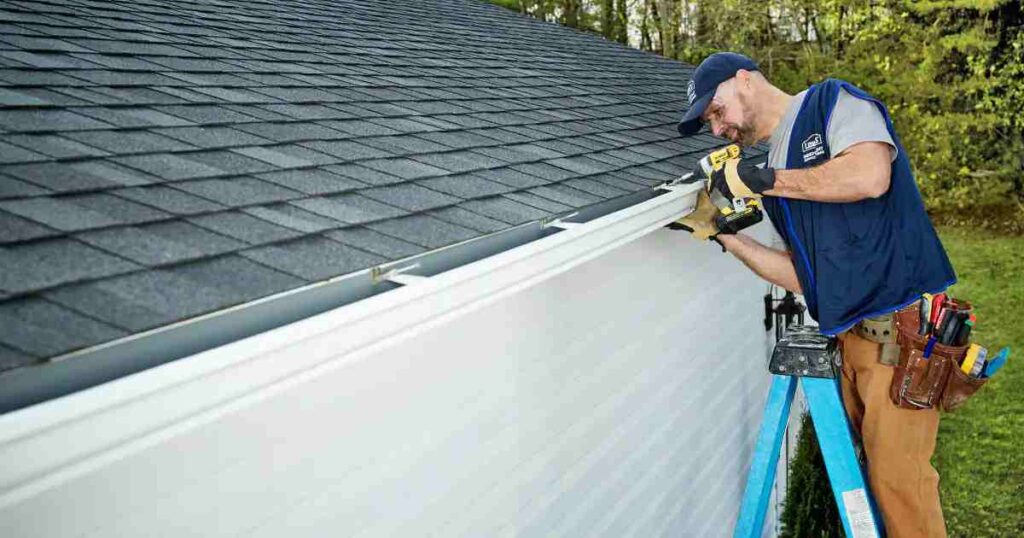Regular inspection of gutters is crucial to maintaining the integrity of your home’s exterior. Over time, gutters can accumulate debris, suffer from wear and tear, or even become damaged, leading to potential water damage and structural issues. By inspecting your gutters regularly, you can catch problems early before they escalate into costly repairs. In this proactive approach, Angel Construction Broker LLC ensures that your gutters remain functional and also helps protect your home from water-related damage year-round.
Importance of Regular Gutter Inspections
Regular gutter inspections are vital for maintaining the structural integrity of your home. Gutters play a crucial role in directing rainwater away from your roof, walls, and foundation, preventing water damage and potential structural issues. By inspecting your gutters at least twice a year, you can catch and address minor problems before they escalate into costly repairs.
Neglecting gutter maintenance can result in a range of problems, including water damage to your roof and fascia boards, foundation issues caused by improper drainage, and even basement flooding. Therefore, regular gutter inspections are not just about maintaining your home’s appearance but also about preserving its overall health and safety.
Ideal Frequency for Gutter Inspections
The ideal frequency for gutter inspections is twice a year, typically in the spring and fall. These seasons are critical because they precede and follow the winter months when gutters are most vulnerable to damage from snow and ice. Spring inspections help identify any damage that may have occurred during the winter, such as cracks, sagging, or detachment. Fall inspections, on the other hand, ensure that gutters are clear of fallen leaves and debris before the winter season sets in.
However, the twice-a-year guideline is a general recommendation. Depending on your specific circumstances, you may need to inspect your gutters more frequently. For instance, if you live in an area with frequent storms or have large trees near your home, you might need to perform inspections every few months.
Professional Gutter Inspection Services
While regular DIY inspections and maintenance are essential, hiring a professional gutter inspection service can provide a more thorough and expert assessment of your gutter system. They can also perform more complex tasks such as repairing or replacing damaged sections of the gutter, ensuring proper alignment and slope, and installing gutter guards to prevent future blockages.
Professional gutter installation services typically offer a comprehensive inspection report, detailing the condition of your gutters and any recommended repairs or maintenance. Investing in professional inspections can save you money in the long run by preventing major repairs and extending the lifespan of your gutter system.
Gutter Materials
Different gutter materials require varying levels of maintenance and care. For example, vinyl gutters are lightweight and easy to install but may become brittle over time and require replacement. Aluminum gutters are more durable and resistant to rust but may need periodic cleaning to prevent corrosion. Copper gutters offer aesthetic appeal and long-term durability but require occasional maintenance to retain their luster. Understanding the maintenance needs of your gutter materials helps homeowners prioritize inspections and care practices that extend the lifespan of their gutter system.
DIY Inspections
Performing DIY gutter inspections is an essential skill for homeowners interested in maintaining their gutter system between professional assessments. Start by safely accessing the roof using a ladder and inspecting gutters for visible signs of damage, such as cracks, rust spots, or loose fastenings. Use a garden hose to simulate rainfall and check for proper water flow through gutters and downspouts. Remove any debris by hand or with a gutter scoop and ensure that downspouts are clear of obstructions. Regular DIY inspections allow homeowners to stay proactive about gutter maintenance and address issues promptly.
After Heavy Storms

Heavy storms bring a myriad of challenges, from high winds to torrential rain. These conditions can wreak havoc on gutters, causing them to clog with debris or even sustain structural damage. After a storm, it’s crucial to inspect gutters for blockages caused by leaves, twigs, and other debris that the wind may have carried. Additionally, high winds can cause gutters to detach from their mountings, creating the risk of water damage to the roof and foundation. By checking gutters immediately after heavy storms, homeowners can address issues promptly, ensuring that the gutter system continues to function properly and preventing potential long-term damage.
Seasonal Changes
Seasonal transitions, particularly in the spring and fall, are ideal times for gutter inspections. In the spring, gutters may be filled with remnants of winter, such as ice, snow, and fallen leaves. Inspecting and cleaning gutters in spring prepares them for the rainy season ahead. In the fall, as trees shed their leaves, gutters are prone to clogging. A thorough inspection and cleaning in the fall ensure that gutters are clear and ready to handle the increased rainfall and possible snow accumulation in winter. Seasonal inspections help maintain the effectiveness of the gutter system throughout the year, reducing the risk of water damage to the home.
Before Winter
Winter poses unique challenges for gutter systems, with the potential for ice dams to form. Ice dams occur when melting snow on the roof refreezes in the gutters, creating blockages that prevent proper drainage. This can lead to water backing up under the roof shingles, causing leaks and water damage inside the home. Inspecting gutters before winter allows homeowners to ensure that they are securely fastened and free of debris. Additionally, installing gutter guards or heating cables can help prevent ice dams from forming. By taking these preventive measures, homeowners can protect their homes from the damaging effects of ice and snow during the winter months.
Visible Issues
Sometimes, gutter issues become apparent without the need for a scheduled inspection. Visible signs such as sagging gutters, water overflowing during rain, or sections of the gutter system detaching from the house indicate immediate problems that need to be addressed. Sagging gutters can result from the accumulation of debris, causing excess weight and strain on the gutter brackets. Overflowing water suggests blockages that hinder proper drainage, potentially leading to water damage to the foundation and landscaping. By addressing these visible issues promptly, homeowners can prevent minor problems from escalating into major repairs, ensuring the longevity and efficiency of their gutter systems.

After Nearby Tree Work
Tree work, such as trimming or removal, can significantly impact nearby gutters. Branches and leaves that fall during tree maintenance can clog gutters, obstructing the flow of water and leading to potential damage. After any nearby tree work, it’s essential to inspect and clean gutters to remove any debris that may have accumulated. This not only ensures the gutters remain clear and functional but also prevents the buildup of organic matter that can lead to rot and attract pests. Regular inspections following tree work contribute to the overall health and maintenance of the gutter system, protecting the home from water damage and preserving the integrity of the roof and foundation.
Impact of Nearby Construction
Construction work near your home can have unintended consequences for your gutter system. Vibrations from heavy machinery or falling debris can loosen gutter fastenings or cause cracks and dents. After nearby construction or renovations, it’s crucial to inspect gutters for any signs of damage. This includes checking for misaligned sections, visible dents or bends, and ensuring that all fastenings are secure. Addressing these issues promptly helps maintain the integrity of your gutter system and prevents water leakage or overflow during rainstorms.
Routine Maintenance
Establishing a routine maintenance schedule for gutter inspections is essential for proactive home care. Regularly scheduled inspections, such as quarterly or bi-annual checks, ensure that gutters remain clear and functional throughout the year. This consistency allows homeowners to detect minor issues early, such as small leaks or developing rust, before they escalate into more significant problems. Routine maintenance also includes cleaning gutters of debris and inspecting downspouts for obstructions, ensuring proper water flow away from the foundation and preventing water damage to the home.
Conclusion
Regular gutter inspections are a critical aspect of home maintenance, protecting against water damage and ensuring the longevity of the gutter system. By addressing factors such as nearby construction impacts, establishing routine maintenance schedules, considering professional inspections, understanding gutter materials, and performing DIY assessments, homeowners can effectively maintain their gutter systems. Properly functioning gutters redirect water away from the home, preventing structural damage and preserving curb appeal. Consistent inspection and maintenance efforts contribute to a healthier, more resilient home environment, enhancing overall property value and homeowner satisfaction.
